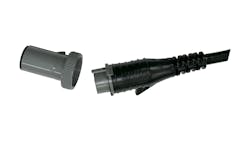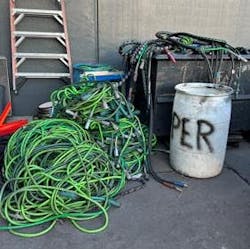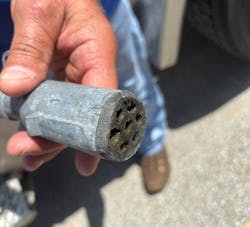Peterson launches first-of-its-kind Repairable J560 Connector
A damaged J560 7-pin connector can stop a fleet delivery in its tracks, as without it, most trailers have no way to power their lights. And fixing one requires replacing the whole cable, commonly comprising a bundle of two pneumatic lines and one electrical. It might even take more than one attempt for less skilled technicians.
"That's a huge parts expense that you don't need to spend,” said Al Anderson, VP of sales and marketing for Peterson Manufacturing.
Anderson said this inefficiency led the lighting and electrical solution provider to ask: “Why replace the whole chord if just the end is bad?”
It turns out, you don't have to. Peterson Manufacturing found an easier fix with the Repairable J560 Connector, which has a detachable head that can be swapped out in under a minute without the use of tools, allowing the undamaged cable to stay in service.
Peterson notes the directions come down to “twist, lock, and go.”
Available in multiple custom cord configurations, this repairable 7-way is more durable and corrosion-resistant, built to survive the harsh road and weather conditions and perform “as well or better” than a standard J560, Anderson told Fleet Maintenance.
He added that conserving the cords saves fleets money and reduces scrap.
Rollout and scalability can vary by fleet, depending on new repairs, but Anderson sees LTL fleets being the earliest adopters of the new connector “because their equipment typically comes back to the same shop pretty much every night, or close to every night.”
How J560s get damaged
Maintenance issues with these 7-way pin connectors are a common lead to downtime and supply disruptions, as well as added parts and labor costs. Operating a trailer with a damaged J560 also presents major safety issues, including potential ABS failures, loss of brake lights, turn signals, and trailer lamps, along with auxiliary power disruptions.
All J560s are prone to normal wear, with those operating in harsher climates at accelerated risk from road salts that corrode the pins. A decade ago, Phillips found that 120 hours of exposure to a brine spray resulted in J560 failure.
The more immediate threats are driver error. This can happen if the driver pulls away from the trailer without disconnecting.
The other common way is letting a disconnected cable dangle after dropping a dolly. The cord will skid along rough surfaces and can get caught under tires.
Ideally, you don't want your drivers to make these mental mistakes, but even when they do, fleets using a repairable connector will save time on repairs and associated costs.
Industry detaching from J560?
It should be noted the American Trucking Associations’ Technology & Maintenance Council is currently investigating replacements for the J560 as the demands for trailer technology are exceeding what the seven-way connector can transmit.
“Multi-voltage requirements, solar installations, electric drive and regenerative braking axles, advanced driver assistance systems (ADAS) and automated driving systems’ (ADS)—and the host of sensors, emitters, and cameras that support them—mean the need for a new connector standard is increasingly necessary and urgent,” noted TMC Executive Director Robert Braswell.
About the Author

Lucas Roberto
Lucas Roberto is an Associate Editor for Fleet Maintenance magazine. He has written and produced multimedia content over the past few years and is a newcomer to the commercial vehicle industry. He holds a bachelor's in media production and a master's in communication from High Point University in North Carolina.



